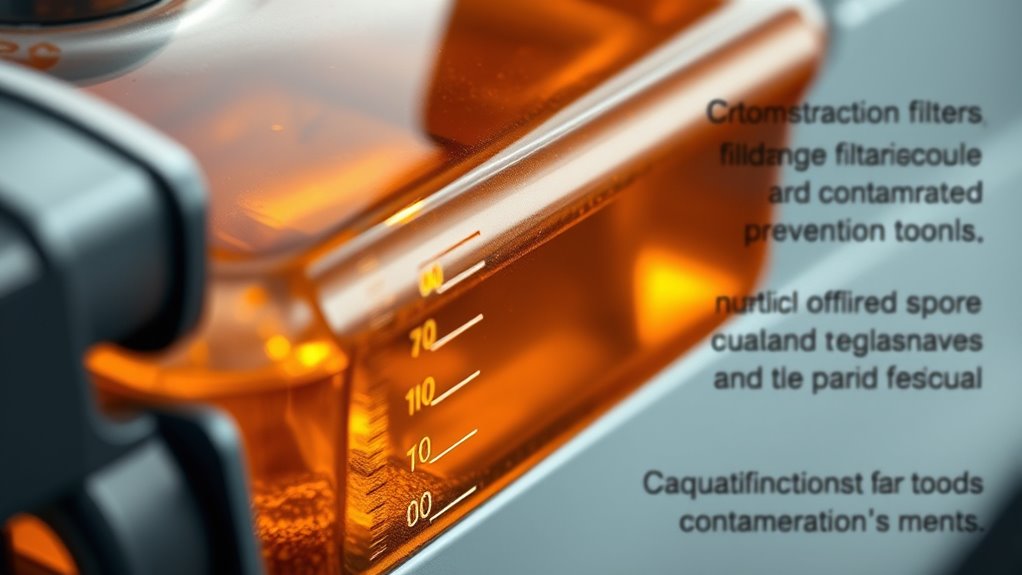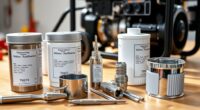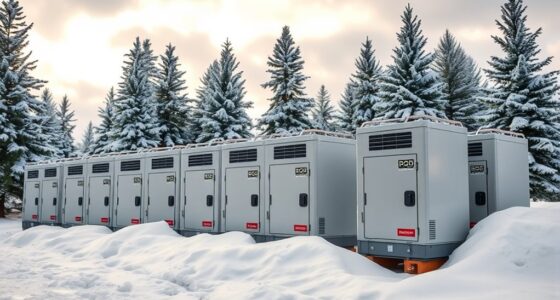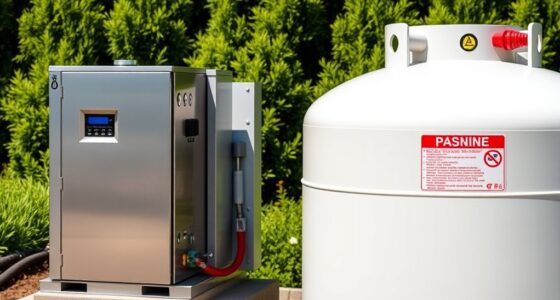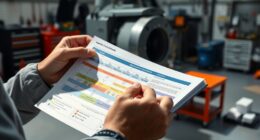To prevent fuel contamination and guarantee top quality, focus on proper storage conditions with stable temperatures, sealed tanks, and good ventilation. Use certified filtration during all transfers, and keep tanks and equipment clean. Regularly test and sample fuel with calibrated tools, monitor treatments, and adjust as needed. Implement advanced technology for real-time oversight, train staff on best practices, and schedule proactive maintenance. If you follow these rules closely, you’ll discover how to keep fuel pure and engine-ready at all times.
Key Takeaways
- Implement certified filtration systems during all fuel transfers to remove particles, water, and debris effectively.
- Conduct regular, representative sampling and detailed testing to detect contamination early and ensure fuel quality compliance.
- Maintain controlled storage environments with stable temperature, humidity, and proper sealing to prevent microbial growth and moisture buildup.
- Train personnel thoroughly on handling, inspection, and maintenance protocols to minimize contamination risks.
- Utilize advanced monitoring technologies and automated alerts for real-time detection of fuel quality deviations.
Prioritize Proper Storage Conditions to Minimize Contamination Risks

Proper storage conditions are vital to keep fuel clean and prevent contamination. You should monitor temperature control carefully, as fluctuations can cause condensation or fuel degradation. Maintaining a stable environment minimizes the risk of moisture buildup, which leads to microbial growth and contamination. Container integrity is equally essential; ensure tanks and containers are sealed tightly, free from leaks, and resistant to corrosion. Regular inspections help detect any damage early, preventing dirt or water ingress. Proper ventilation and avoiding exposure to direct sunlight also support fuel quality. Additionally, selecting the right storage media can enhance protection against contamination. By controlling temperature and safeguarding container integrity, you create a storage environment that preserves fuel purity, reduces contamination risks, and extends storage life. These steps are fundamental to maintaining high fuel standards over time.
Implement Rigorous Fuel Sampling and Testing Protocols
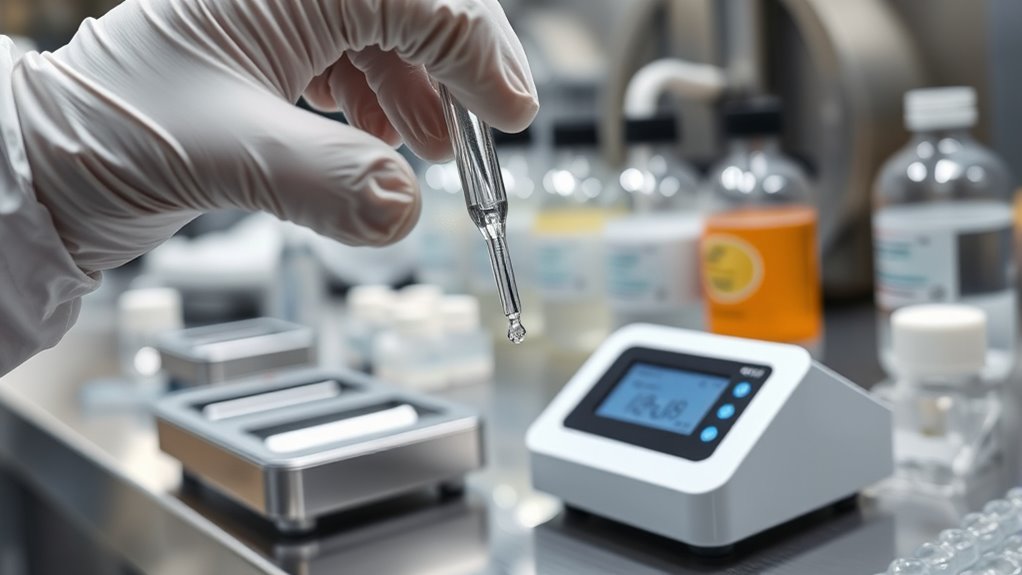
To guarantee fuel quality, you need to adopt precise sampling accuracy techniques and follow a consistent testing frequency schedule. Keeping detailed records of all test results helps identify trends and prevent contamination issues early. Implementing these protocols keeps your fuel clean and your equipment running smoothly. Regularly reviewing vetted industry standards ensures your procedures align with the latest best practices.
Sampling Accuracy Techniques
Implementing rigorous fuel sampling and testing protocols is essential for ensuring accurate fuel quality assessments. To achieve this, focus on sampling precision by carefully collecting representative samples that reflect the true condition of the entire fuel batch. Use proper measurement techniques, such as calibrated sampling equipment and standardized procedures, to prevent contamination and errors. Make certain samples are taken at consistent intervals and from multiple points within storage tanks to account for potential variations. Avoid sample handling mistakes that could skew results, like exposure to moisture or temperature fluctuations. Accurate measurement techniques help you detect contaminants and quality deviations early. By emphasizing sampling precision and disciplined measurement practices, you strengthen your ability to maintain fuel integrity and prevent contamination issues effectively. Additionally, staying informed about automation technologies can help optimize sampling processes and improve overall efficiency.
Testing Frequency Schedule
Establishing a regular testing schedule guarantees fuel quality remains consistent and contaminants are detected early. Consistent testing helps you identify contamination sources before they cause significant issues, especially during fuel blending processes. By testing at set intervals, you can monitor for deviations in fuel properties and catch potential contamination from storage tanks, transportation, or mixing errors. A rigorous schedule ensures you don’t overlook subtle changes that could compromise fuel integrity. It also helps you maintain compliance with industry standards and supports prompt corrective actions. Tailoring your testing frequency based on fuel usage volume, storage duration, and known contamination risks ensures you stay proactive. Regular testing builds confidence in your fuel quality and minimizes the chances of contaminated fuel reaching your end users. Additionally, understanding the role of color accuracy in fuel characteristics can help you better interpret test results and identify anomalies early.
Data Record Keeping
Maintaining meticulous records of fuel sampling and testing activities is essential for guaranteeing data integrity and traceability. Proper documentation helps you verify fuel quality and detect contamination issues early. To strengthen contamination prevention efforts, consider these key practices:
- Record detailed sample collection data, including date, time, location, and sampling methods.
- Document test results thoroughly, noting any deviations from acceptable fuel quality standards.
- Keep logs of maintenance and calibration of testing equipment to ensure consistent, reliable results.
- Implement Vetted testing protocols to standardize procedures and improve the accuracy of contamination detection.
Use Certified Filtration Systems for All Fuel Transfers
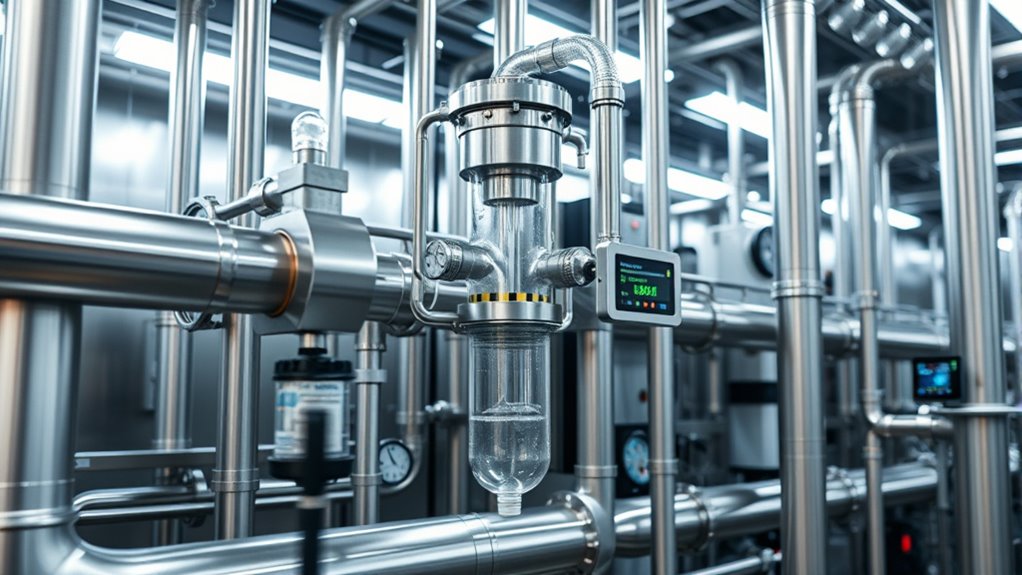
Using certified filtration systems during fuel transfers guarantees effective removal of contaminants and maintains fuel quality. They help prevent contamination risks that can damage equipment or impair performance. Additionally, certified systems meet industry standards, giving you confidence in your fuel management process. Incorporating high-quality filtration can further enhance the purity of your fuel, reducing the likelihood of issues caused by impurities.
Ensures Effective Filtration
To guarantee fuel remains free of contaminants during transfers, it’s essential to rely on certified filtration systems. These systems effectively remove particles, water, and debris that can originate from contamination sources or fuel additives. By doing so, you prevent clogging filters, engine damage, and costly repairs.
Consider these key steps:
- Use high-quality filters rated for your specific fuel type to catch even the smallest particles.
- Regularly inspect and replace filters to maintain peak filtration efficiency.
- Ensure proper setup during transfers to avoid introducing new contaminants.
Effective filtration not only improves fuel quality but also extends equipment lifespan. Relying on certified systems guarantees that contaminated fuel doesn’t slip through, safeguarding your operations from avoidable issues.
Prevents Contamination Risks
Implementing certified filtration systems during all fuel transfers is your best defense against contamination risks. These systems remove dirt, water, and particles that can compromise fuel quality. When performing fuel blending, contamination prevention becomes even more critical, as impurities can affect the final product’s performance. Using proper filtration ensures contaminants don’t enter storage tanks or engines, reducing costly repairs and downtime. Proper asset management and adherence to fuel quality standards further enhance contamination prevention efforts.
Meets Industry Standards
Adhering to industry standards requires that you employ certified filtration systems for all fuel transfers. Using approved systems ensures your fuel blending processes meet quality benchmarks, reducing contamination risks. These systems support additive optimization by maintaining fuel purity, which maximizes additive effectiveness. To stay compliant, focus on:
- Regularly inspecting and maintaining filtration equipment
- Ensuring filters meet certification requirements for fuel quality
- Using certified filtration during transfer to prevent dirt, water, and debris from entering the fuel system
- Selecting filtration systems compatible with electric bikes and generators to prevent electrical component contamination
Implementing these practices guarantees your fuel meets industry standards, preserves fuel integrity, and promotes efficient, contamination-free operations. Certified filtration systems are a critical part of maintaining high-quality fuel and ensuring reliable performance throughout all transfer stages.
Maintain Strict Cleanliness During Fuel Handling and Servicing

Why is maintaining strict cleanliness during fuel handling and servicing so critical? Because even tiny contaminants can compromise fuel quality, cause engine damage, and increase maintenance costs. During fuel blending, any dirt, debris, or residual contaminants from previous operations can introduce contamination sources into the fuel. These impurities can lead to inconsistent fuel properties, clog filters, or damage sensitive engine parts. Ensuring cleanliness involves thoroughly cleaning tanks, refueling equipment, and storage containers before use. Always use proper procedures to prevent dirt and debris from entering fuel systems. Implementing regional legal resources can help ensure compliance with safety standards and regulations. By staying vigilant about cleanliness, you minimize contamination sources, protect fuel integrity, and maintain *ideal* engine performance. Clean handling practices are essential for preventing costly issues and ensuring the longevity of your equipment.
Regularly Monitor and Adjust Fuel Additive Treatments
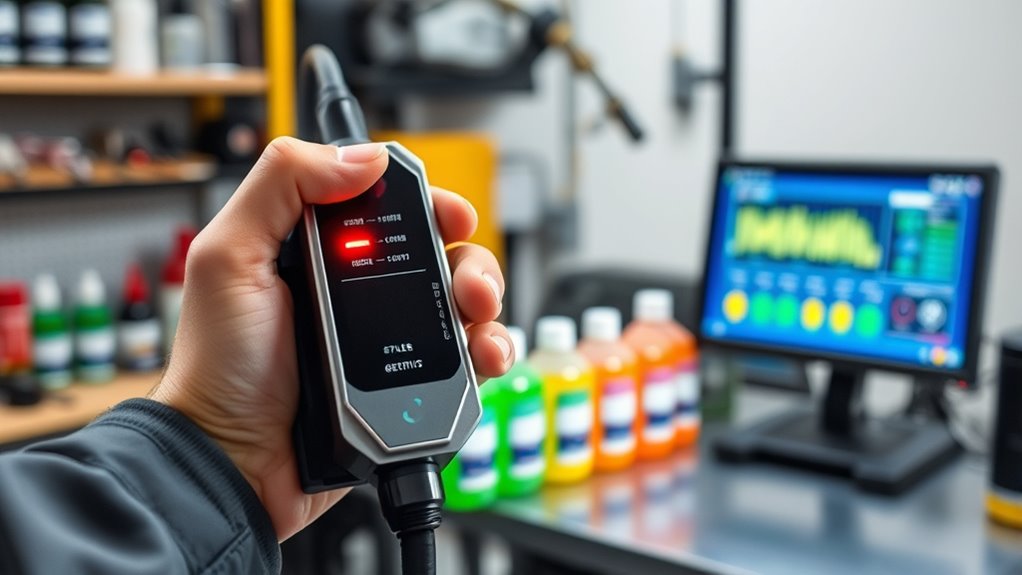
Regularly monitoring and adjusting fuel additive treatments is essential to guarantee ideal fuel performance and engine protection. Consistent oversight helps you optimize fuel additive levels and detect contamination early. To do this effectively, consider these key actions:
Regular monitoring ensures optimal fuel quality and engine protection through early detection and adjustment.
- Track fuel quality indicators to identify when additive levels need tweaking for maximum fuel additive effectiveness.
- Conduct contamination detection tests regularly to catch impurities before they cause damage.
- Adjust additive treatments based on test results to maintain proper chemical balance and prevent deposit buildup.
Establish Controlled Environments for Fuel Storage and Dispensing
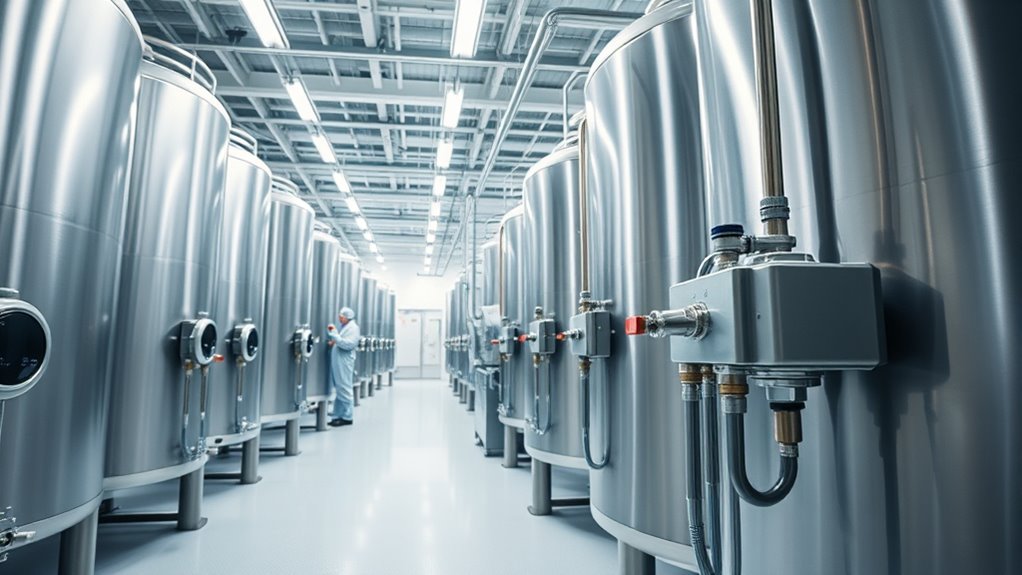
To prevent fuel contamination and guarantee quality, establishing controlled environments for storage and dispensing is essential. Use clear fuel color coding to distinguish different fuel types, reducing the risk of cross-contamination. Proper storage tank labeling helps identify contents accurately, ensuring correct handling and compliance. Keep storage areas clean and sealed, controlling temperature, humidity, and exposure to contaminants. Limit access to authorized personnel only, and implement strict procedures for filling and dispensing. Regular inspections of storage tanks and dispensing equipment prevent leaks and deterioration. By maintaining controlled environments, you minimize contamination risks and preserve fuel integrity. Consistent use of color coding and labeling streamlines operations, improves safety, and ensures fuel quality remains uncompromised throughout the storage and dispensing process. Additionally, dog names can be used as a fun way to organize and personalize equipment or areas related to fuel management, fostering better identification and team engagement.
Adopt Advanced Monitoring Technologies for Real-Time Quality Assessment

Implementing advanced monitoring technologies enables you to assess fuel quality in real time, minimizing contamination risks and maintaining consistent standards. Biometric sensors can be integrated into storage systems to detect impurities or deviations instantly. Cloud analytics then processes this data continuously, providing actionable insights and trend analysis. To optimize your fuel quality management, consider these steps:
- Install biometric sensors at critical points to monitor contamination levels continuously.
- Utilize cloud analytics platforms to analyze sensor data, identify patterns, and flag anomalies immediately.
- Automate alerts and reporting to respond swiftly to potential issues before they escalate.
Train Personnel on Best Practices for Fuel Management

Training personnel on best practices for fuel management is essential to safeguard against contamination and guarantee quality standards. Proper education ensures staff understand the importance of fuel testing and contamination control measures. Regular training covers safe handling, storage procedures, and inspection routines, minimizing risks. Use the following table to reinforce key areas:
| Practice | Description | Importance |
|---|---|---|
| Fuel Testing | Regularly analyze samples for quality assurance | Detects contamination early |
| Contamination Control | Maintain cleanliness in storage and equipment | Prevents fuel degradation |
| Proper Storage | Use sealed tanks, avoid exposure | Reduces environmental risk |
| Handling Procedures | Follow safety protocols during transfer | Ensures personnel safety |
Consistent training keeps your team sharp, ensuring fuel integrity and contamination prevention.
Develop a Proactive Maintenance Schedule to Detect and Address Contamination Early
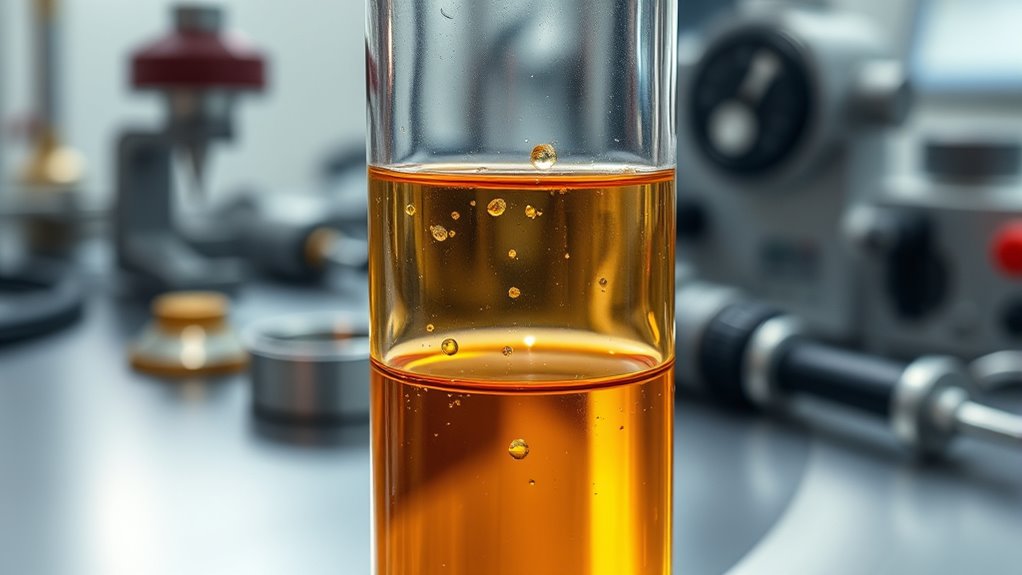
A well-structured maintenance schedule is your frontline defense against fuel contamination. By regularly inspecting and testing your fuel system, you can catch contamination early before it causes damage. Understanding contamination pathways helps you identify vulnerable points to monitor closely. Proper maintenance scheduling guarantees timely filter changes, tank inspections, and water removal.
Here are key steps to develop an effective proactive plan:
- Schedule routine tank and fuel system inspections to identify contamination pathways early.
- Implement regular filter changes and water removal to prevent buildup.
- Track fuel quality trends and adjust maintenance activities accordingly to stay ahead of potential issues.
This approach minimizes risks, reduces downtime, and keeps your fuel quality intact.
Frequently Asked Questions
How Often Should Fuel Samples Be Tested for Contamination?
You should test fuel samples for contamination regularly, ideally every 3 to 6 months, depending on storage conditions and usage. Maintaining a consistent sampling frequency helps with early contamination detection, preventing costly engine issues. If your fuel is stored longer or exposed to adverse conditions, increase testing frequency. This proactive approach ensures fuel quality stays high, reducing risks and maintaining ideal engine performance.
What Are the Most Common Sources of Fuel Contamination?
Ever wonder where fuel contamination sneaks in? It’s usually from fuel additives gone rogue or poor storage tank maintenance. Contaminants like water, dirt, and microbes love to hide in neglected tanks or get introduced during careless handling. Keep your tanks sealed, clean, and monitor fuel additives carefully. That way, your engine stays happy, and you avoid the nightmare of clogged filters and costly repairs. Stay vigilant; your fuel’s health depends on it!
Which Filtration Systems Are Best for Different Fuel Types?
You should choose filtration systems based on fuel type and required filtration efficiency. For diesel, high-efficiency spin-on filters offer reliable removal of particulates and water, ensuring fuel compatibility. Gasoline systems benefit from fine mesh filters that prevent debris without restricting flow. Always match your filter’s specifications with your fuel’s viscosity and contaminants, and regularly maintain and replace filters to optimize performance and prevent contamination.
How Can Personnel Be Effectively Trained on Fuel Handling?
To guarantee safe and efficient fuel handling, you should develop thorough personnel training programs that emphasize proper fuel handling procedures from the start. Use hands-on workshops, visual aids, and regular refreshers to reinforce best practices. Encourage questions and active participation, making training engaging and memorable. Continuous evaluation and feedback help identify gaps, ensuring your team stays well-informed and confident in managing fuel quality and contamination risks effectively.
What Technologies Enable Real-Time Fuel Quality Monitoring?
You can enable real-time fuel quality monitoring through sensor integration, which provides continuous data on fuel parameters like viscosity and contamination levels. Combined with data analytics, these sensors help you detect issues early, ensuring fuel integrity. Implementing this technology allows you to promptly address contamination, optimize fuel handling, and maintain high quality standards, ultimately reducing risks and improving operational efficiency.
Conclusion
By following these nine rules, you’ll markedly reduce fuel contamination risks. Think of it like safeguarding a delicate ecosystem—if you ignore even one element, it could upset the balance. With diligent storage, testing, and monitoring, you prevent costly issues before they arise. Picture yourself confidently managing fuel quality, avoiding breakdowns and downtime. Stay proactive, and you’ll keep your fuel pristine and your operations running smoothly, no matter how challenging the environment.
